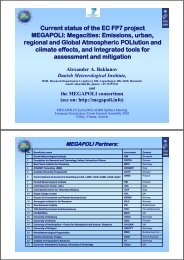MEGAPOLI Megacities: Emissions, urban ... - MEGAPOLI - DMI
MEGAPOLI Megacities: Emissions, urban ... - MEGAPOLI - DMI
MEGAPOLI Megacities: Emissions, urban ... - MEGAPOLI - DMI
You also want an ePaper? Increase the reach of your titles
YUMPU automatically turns print PDFs into web optimized ePapers that Google loves.
FP7 EC <strong>MEGAPOLI</strong> Project<br />
2. Model Description and Application<br />
2.1 PMCAMx-2008<br />
2.1.1 Model description<br />
PMCAMx-2008 (Murphy and Pandis, 2009; Tsimpidi et al., 2010; Karydis et al., 2010) uses the<br />
framework of the CAMx air quality model (Environ, 2003) describing the processes of horizontal<br />
and vertical advection, horizontal and vertical dispersion, wet and dry deposition, and gas-phase<br />
chemistry. For the aerosol processes, three detailed aerosol modules are used. The approach of<br />
Fahey and Pandis (2001) is used for the simulation of aqueous-phase chemistry. The inorganic<br />
aerosol growth is described in Gaydos et al., (2003) and Koo et al., (2003), and the secondary organic<br />
aerosol (SOA) formation and growth in Koo et al. (2003). These aerosol modules use a sectional<br />
approach to dynamically track the size evolution of the aerosol mass across 10 size sections<br />
spanning from 40 nm to 40 μm. The aerosol species modeled include sulfate, nitrate, ammonium,<br />
sodium, chloride, potassium, calcium, magnesium, elemental carbon, primary and secondary organics.<br />
The chemical mechanism used in the gas-phase chemistry is based on the SAPRC99 mechanism<br />
(Carter, 2000; Environ, 2003). The mechanism includes 211 reactions of 56 gases and 18<br />
radicals.<br />
Three options are available in PMCAMx-2008 for the simulation of inorganic aerosol growth. The<br />
most computationally efficient approach is the bulk equilibrium approach, which assumes equilibrium<br />
between the bulk inorganic aerosol and gas phase. At a given time step the amount of each<br />
species transferred between the gas and aerosol phases is determined by applying the aerosol thermodynamic<br />
equilibrium model ISORROPIA (Nenes et al., 1998) and is then distributed over the<br />
aerosol size sections by using weighting factors for each size section based on their surface area<br />
(Pandis et al., 1993). The second approach (hybrid approach) assumes equilibrium for the fine particles<br />
(




